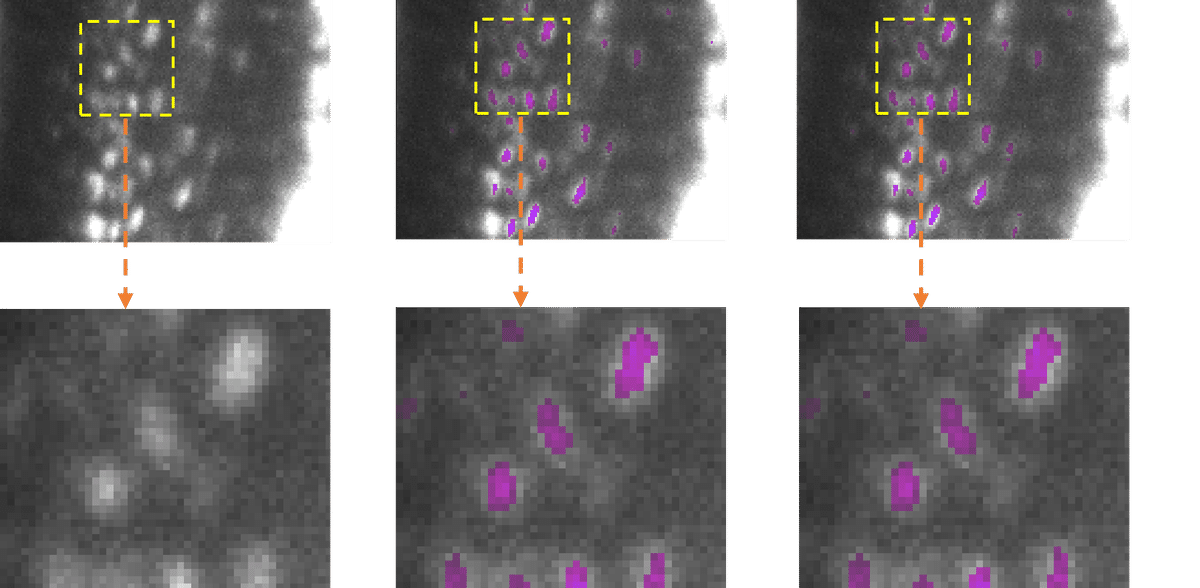Analysis of Microscopic Images: New Open-Source Software Makes AI Models Lighter & Greener
No special knowledge required
artificial intelligence (AI) has become an indispensable component in the analysis of microscopic data. However, while AI models are becoming better and more complex, the computing power and associated energy consumption are also increasing. Researchers at the Leibniz-Institut für Analytische Wissenschaften (ISAS) and Peking University have therefore created a free compression software that allows scientists to run existing bioimaging AI models faster and with significantly lower energy consumption. The researchers have now presented their user-friendly toolbox called EfficientBioAI (open source) in Nature Methods.
Modern microscopy techniques produce a large number of high-resolution images, and individual data sets can comprise thousands of them. Scientists often use AI-supported software to reliably analyse these data sets. However, as AI models become more complex, the latency (processing time) for images can significantly increase. “High network latency, for example with particularly large images, leads to higher computing power and ultimately to increased energy consumption”, says Dr Jianxu Chen, head of the AMBIOM - Analysis of Microscopic BIOMedical Images junior research group at ISAS.
A well-known technique finds new applications
To avoid high latency in image analysis, especially on devices with restricted computing power, researchers use sophisticated algorithms to compress the AI models. This means they reduce the amount of computations in the models while retaining comparable prediction accuracy. “Model compression is a technique that is widely used in the field of digital image processing, known as computer vision, and AI to make models lighter and greener,” explains Chen. Researchers combine various strategies to reduce memory consumption, speed up model inference, the ‘thought process’ of the model - and thus save energy. Pruning, for example, is used to remove excess nodes from the neural network. “These techniques are often still unknown in the bioimaging community. Therefore, we wanted to develop a ready-to-use and simple solution to apply them to common AI tools in bioimaging”, says Yu Zhou, the paper's first author and PhD student at AMBIOM.
Energy savings of up to roughly 81 per cent
To put their new toolbox to the test, the researchers led by Chen tested their software on several real-life applications. With different hardware and various bioimaging analysis tasks, the compression techniques were able to significantly reduce latency and cut energy consumption by between 12.5 and 80.6 per cent. “Our tests show that EfficientBioAI can significantly increase the efficiency of neural networks in bioimaging without limiting the accuracy of the models”, summarises Chen. He illustrates the energy savings using the commonly used CellPose model as an example: if a thousand users were to use the toolbox to compress the model and apply it to the Jump Target ORF dataset (around one million microscope images of cells) they could save energy equivalent to the emissions of a car journey of around 7,300 miles (approx. 11,750 kilometres).
No special knowledge required
The authors are keen to make EfficientBioAI accessible to as many scientists in biomedical research as possible. Researchers can install the software and seamlessly integrate it into existing PyTorch libraries (open-source programme library for the Python programming language). For some widely used models, such as Cellpose, researchers can therefore use the software without having to make any changes to the code themselves. To support specific change requests, the group also provides several demos and tutorials. With just a few changed lines of code, the toolbox can then also be applied to customised AI models.
Original publication
Most read news
Original publication
Yu Zhou, Jiajun Cao, Justin Sonneck, Sweta Banerjee, Stefanie Dörr, Anika Grüneboom, Kristina Lorenz, Shanghang Zhang, Jianxu Chen; "EfficientBioAI: making bioimaging AI models efficient in energy and latency"; Nature Methods, 2024-1-24
Topics
Organizations
Related link
These products might interest you

Limsophy by AAC Infotray
Optimise your laboratory processes with Limsophy LIMS
Seamless integration and process optimisation in laboratory data management

LAUDA.LIVE by LAUDA
LAUDA.LIVE - The digital platform for your device management
Comprehensive fleet management options for every LAUDA device - with and without IoT connectivity

Get the analytics and lab tech industry in your inbox
By submitting this form you agree that LUMITOS AG will send you the newsletter(s) selected above by email. Your data will not be passed on to third parties. Your data will be stored and processed in accordance with our data protection regulations. LUMITOS may contact you by email for the purpose of advertising or market and opinion surveys. You can revoke your consent at any time without giving reasons to LUMITOS AG, Ernst-Augustin-Str. 2, 12489 Berlin, Germany or by e-mail at revoke@lumitos.com with effect for the future. In addition, each email contains a link to unsubscribe from the corresponding newsletter.
























































